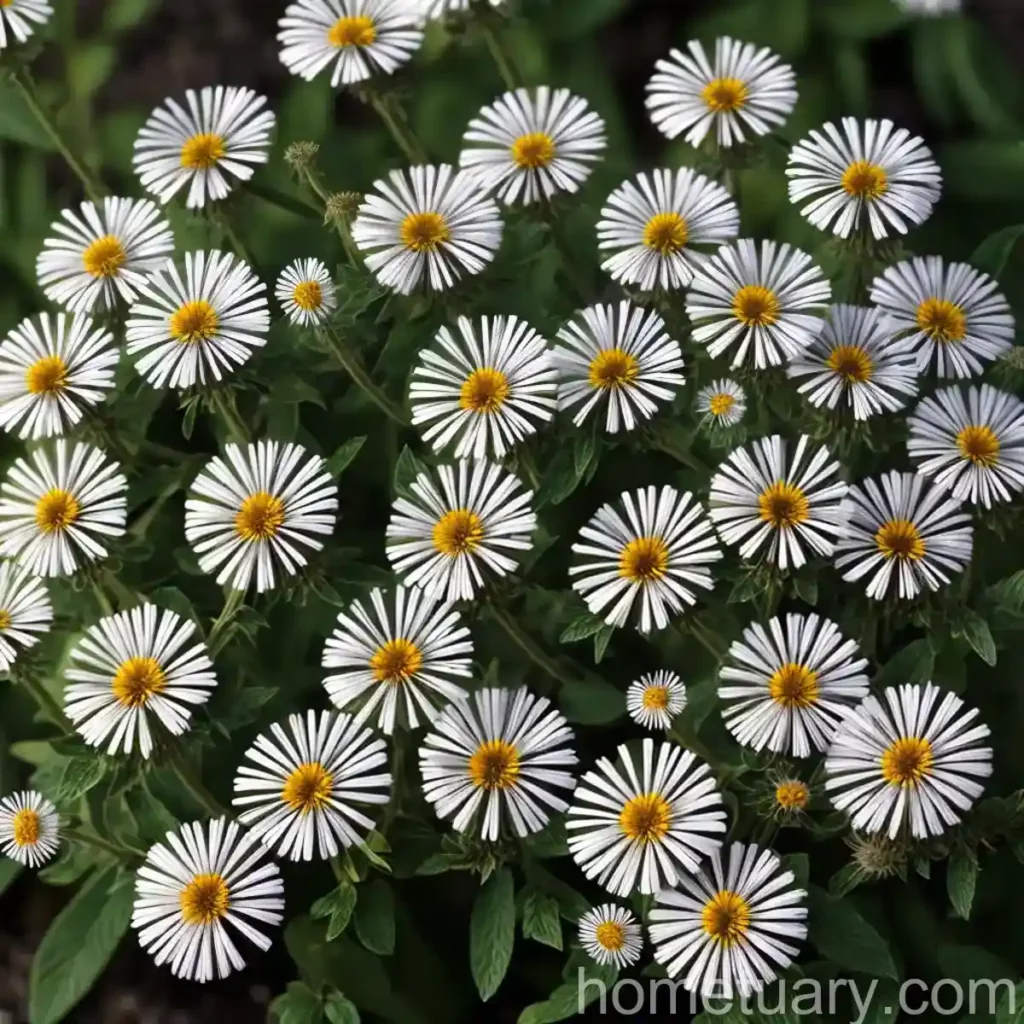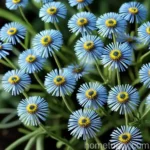Common Fleabane (Erigeron philadelphicus): A Comprehensive Guide
What is Erigeron philadelphicus?
Erigeron philadelphicus, commonly known as common fleabane, is a perennial herbaceous plant from the Asteraceae family. This native plant of North America is widely recognized for its delicate white or pale pink flowers, which are characterized by their daisy-like appearance.
Erigeron philadelphicus Characteristics
Some key characteristics of Erigeron philadelphicus include:
– Family: Asteraceae
– Common Name: Common Fleabane
– Type: Perennial
– Flowers: White or pale pink, daisy-like
– Height: Typically reaches 1 to 3 feet in height
– Habitat: Found in open woods, fields, and disturbed areas
– Blooms: Late spring to early summer
Key Takeaways – Common Fleabane (Erigeron philadelphicus)
Erigeron philadelphicus is a versatile plant with various cultural, medicinal, and ecological uses. Understanding its cultural requirements, uses, and unique characteristics is essential for anyone interested in cultivating or appreciating this plant.
Erigeron philadelphicus Plant Profile
- Scientific Name: Erigeron philadelphicus
- Common Name: Common Fleabane
- Family: Asteraceae
- Type: Perennial Herbaceous Plant
- Origin: North America
- USDA Hardiness Zones: 3 to 8
- Bloom Time: Late spring to early summer
- Light Requirements: Full sun to partial shade
Culture
Cultivating Erigeron philadelphicus requires a good understanding of its cultural needs, including water, sunlight, soil, and fertilizer preferences.
Water
Erigeron philadelphicus thrives in well-draining soil and prefers moderate moisture levels. While it can withstand short periods of drought, consistent watering is essential, especially during its active growth periods.
Sunlight
This plant prefers full sun to partial shade, making it suitable for a wide range of garden environments. However, in regions with hot summers, providing some shade during the hottest part of the day can help prevent the plant from wilting.
Fertilizer
Common Fleabane generally doesn’t require heavy feeding. A balanced, all-purpose fertilizer applied in the spring can support its growth and flowering. Avoid over-fertilization, as it can lead to excessive foliage growth at the expense of flower production.
Soil
Erigeron philadelphicus prefers well-draining, slightly acidic to neutral soil. Amending heavy clay soils with organic matter can enhance drainage and improve growing conditions for this plant.
Uses
The uses of Erigeron philadelphicus extend beyond its ornamental value, with various medicinal, landscaping, and ecological applications.
Medicinal Properties
- Traditional medicine uses the plant as an astringent and diuretic
- Some indigenous communities use it for pain relief or to treat minor cuts and bruises
Landscaping
- Common Fleabane is a valuable addition to wildflower gardens, meadows, and naturalistic landscapes
- Its delicate flowers and clumping habit make it an attractive choice for cottage gardens
Ecological Significance
- Provides nectar and pollen for various pollinators, including bees and butterflies
- Contributes to the natural biodiversity of open woodlands and fields
Erigeron philadelphicus Habitat
Erigeron philadelphicus is commonly found in open woods, fields, meadows, and disturbed areas. It is well-adapted to a wide range of habitats, from dry, rocky slopes to moist, open woodlands.
Common Fleabane Culinary and Herbal Uses
While not as commonly utilized for culinary purposes, some herbal remedies and teas attribute medicinal properties to Common Fleabane. However, it’s important to note that proper guidance from a professional is essential before considering any plant for medicinal use.
Growing Erigeron philadelphicus
Cultivating Erigeron philadelphicus can be a rewarding experience for home gardeners and horticultural enthusiasts. Understanding the specific care tips and requirements for this plant is crucial to its successful growth.
Erigeron philadelphicus Care Tips
- Regular watering, especially during the plant’s active growth phase
- Pruning to remove spent flowers can promote continued blooming
- Mulching around the base of the plant can help retain moisture and regulate soil temperature
Common Fleabane Natural Remedies
The traditional medicinal uses of Common Fleabane are rooted in its astringent properties. It has been used externally to stem bleeding and promote wound healing. However, it’s essential to seek professional guidance before using any herbal remedies.
Erigeron philadelphicus Folklore and Symbolic Meaning
Common Fleabane has a rich history of folklore and symbolic significance in various cultures. Its association with healing and protection is reflected in many traditional stories and beliefs.
Benefits of Common Fleabane
The benefits of Common Fleabane go beyond its ornamental value, extending into ecological, medicinal, and symbolic realms. Understanding and appreciating these benefits can deepen one’s connection with the plant.
Erigeron philadelphicus Cultivation Guide
- Planting Time: Spring or fall
- Spacing: 12-18 inches apart
- Maintenance: Moderate
- Propagation: Division or seeds
Common Fleabane Symbolic Meaning
Throughout history, Common Fleabane has been associated with protection, healing, and resilience in various cultures and traditions. Its symbolic significance adds an intriguing layer to its value.
Erigeron philadelphicus Landscaping Ideas
Incorporating Erigeron philadelphicus into landscaping designs can add a naturalistic and wildflower aesthetic to outdoor spaces. Its delicate flowers and adaptability make it a versatile choice for various landscape styles.
Common Fleabane Plant Family
Erigeron philadelphicus belongs to the Asteraceae family, which is known for its diverse array of flowering plants. Understanding a plant’s botanical family can provide insights into its characteristics and behavior.
Erigeron philadelphicus Common Names
Common Fleabane is known by various names, reflecting its geographical distribution and cultural significance. Recognizing its different common names can offer insights into its historical and regional uses.
Common Fleabane Health Benefits
While not widely recognized for direct health benefits, some traditional medicinal uses of Common Fleabane attribute healing properties to the plant, primarily in the context of wound care and minor ailments.
Erigeron philadelphicus Folklore and Myths
The folklore and myths surrounding Erigeron philadelphicus offer a glimpse into the cultural significance and traditional beliefs associated with this plant. Exploring these narratives can deepen one’s appreciation for its rich history.
Common Fleabane Herbal Uses
Common Fleabane has been utilized in traditional herbal remedies for its purported astringent and healing properties. While its herbal uses are not as prevalent today, it remains an intriguing botanical subject in the context of herbalism.
Erigeron philadelphicus Wildlife Benefits
The nectar and pollen of Erigeron philadelphicus attract a variety of pollinators, contributing to the ecological value of the plant. Its role in supporting local wildlife is an essential aspect of its overall significance.
Common Fleabane Gardening Tips
Integrating Common Fleabane into garden settings requires an understanding of its cultural requirements and potential design impacts. Implementing effective gardening practices can enhance the plant’s performance and overall aesthetic value.
Erigeron philadelphicus Uses in Traditional Medicine
Traditional medicine has utilized Erigeron philadelphicus for various purposes, including wound care, pain relief, and urinary issues. Exploring its historical uses in traditional medicine can offer insights into its broader healing associations.
Common Fleabane Symbolism
The symbolic meanings attributed to Common Fleabane incorporate themes of protection, resilience, and natural healing. Understanding its symbolic significance adds depth to the plant’s cultural and historical value.
Erigeron philadelphicus Natural Habitat
Erigeron philadelphicus is well-adapted to a diverse range of natural habitats, from open woodlands to disturbed areas. Its ability to thrive in various environments contributes to its ecological resilience and adaptability.
Common Fleabane Plant Care Guide
Proper care and maintenance are essential for the successful cultivation of Common Fleabane. Following a comprehensive plant care guide can help maximize its aesthetic and ecological contributions.
Erigeron philadelphicus Traditional Uses
The traditional uses of Erigeron philadelphicus encompass a wide array of applications, from wound care to folk remedies. Exploring its traditional uses can shed light on its historical relevance in cultural practices.
Common Fleabane Ecological Significance
As a native North American plant, Common Fleabane plays a role in supporting local ecosystems and contributing to the natural biodiversity of open woodlands and fields. Understanding its ecological significance is essential for conservation efforts.
Erigeron philadelphicus Unique Features
The unique features of Erigeron philadelphicus, from its delicate flowers to its adaptability, contribute to its overall appeal in horticulture, ecology, and cultural contexts. Recognizing its distinct characteristics adds depth to its botanical allure.
Common Fleabane Herbal Tea Recipe
While less common today, Common Fleabane has been historically used to prepare herbal teas with purported medicinal properties. Exploring herbal tea recipes can provide insights into its traditional uses and preparations.
Erigeron philadelphicus Seasonal Care
Adjusting care practices based on the plant’s seasonal needs is crucial for maintaining its health and vigor. Understanding the seasonal care requirements of Erigeron philadelphicus can support its long-term success in the garden.
Common Fleabane Folklore Remedies
Throughout history, Common Fleabane has been associated with various folklore remedies and beliefs, reflecting its cultural significance and traditional applications. Exploring these folklore remedies can offer a glimpse into its historical uses.
Erigeron philadelphicus Propagation Methods
The propagation of Erigeron philadelphicus can be achieved through division or seeds, with each method offering unique advantages and considerations. Understanding effective propagation methods is crucial for expanding its presence in garden settings.
Common Fleabane Insect Repellent
Some traditional uses of Common Fleabane suggest its effectiveness as an insect repellent. However, it’s important to approach such uses with caution and consider professional guidance when exploring natural pest control methods.
Erigeron philadelphicus Common Pests
While generally resistant to pests and diseases, Erigeron philadelphicus may occasionally encounter common garden pests. Recognizing these potential pests and implementing appropriate control methods is essential for maintaining plant health.
Common Fleabane Landscape Design Tips
Integrating Common Fleabane into landscape designs requires thoughtful consideration of its cultural requirements and visual impact. Implementing effective design tips can enhance its contributions to outdoor spaces.
Conclusion
Erigeron philadelphicus, or Common Fleabane, is a versatile plant with a rich history of cultural, medicinal, and ecological significance. Understanding its characteristics, uses, and care requirements is essential for anyone interested in cultivating, appreciating, or utilizing this plant in various contexts. From its delicate flowers to its folklore and medicinal associations, Common Fleabane offers a diverse array of cultural, ecological, and horticultural benefits.
References
-
“Erigeron philadelphicus – Profile on Illinois Wildflowers”
(https://www.illinoiswildflowers.info/weeds/plants/phil_fleabane.html) -
“Erigeron philadelphicus – USDA PLANTS Database”
(https://plants.usda.gov/home/plantProfile?symbol=ERPH) -
“Growing Native Plants – University of Illinois Extension”
(https://extension.illinois.edu/natives/erigeron_philadelphicus.cfm) -
“Erigeron philadelphicus – Missouri Botanical Garden”
(http://www.missouribotanicalgarden.org/PlantFinder/PlantFinderDetails.aspx?kempercode=c605) -
“A Modern Herbal – Fleabane”
(https://botanical.com/botanical/mgmh/f/fleaba59.html) -
“Fleabane – Erigeron philadelphicus in Schenley Park”
(http://www.birdsoutsidemywindow.org/2018/07/26/fleabane/) -
“Floridata: Erigeron philadelphicus”
(https://floridata.com/plant/1123) -
“PLANTS Profile for Erigeron philadelphicus – USDA NRCS National Plant Data Center”
(https://plants.usda.gov/core/profile?symbol=ERPH) -
“Erigeron philadelphicus in Flora of North America @ efloras.org”
(http://www.efloras.org/florataxon.aspx?flora_id=1&taxon_id=250067362) -
“Erigeron philadelphicus – North American Insects and Spiders”
(https://www.cirrusimage.com/flowers_fleabane/) -
“The Plant List: Erigeron philadelphicus L.”
(http://www.theplantlist.org/tpl1.1/record/gcc-123039) -
“Virginia Tech Weed Identification Guide: Common Fleabane”
(https://oak.ppws.vt.edu/~flessner/weedguide/erph.htm)















